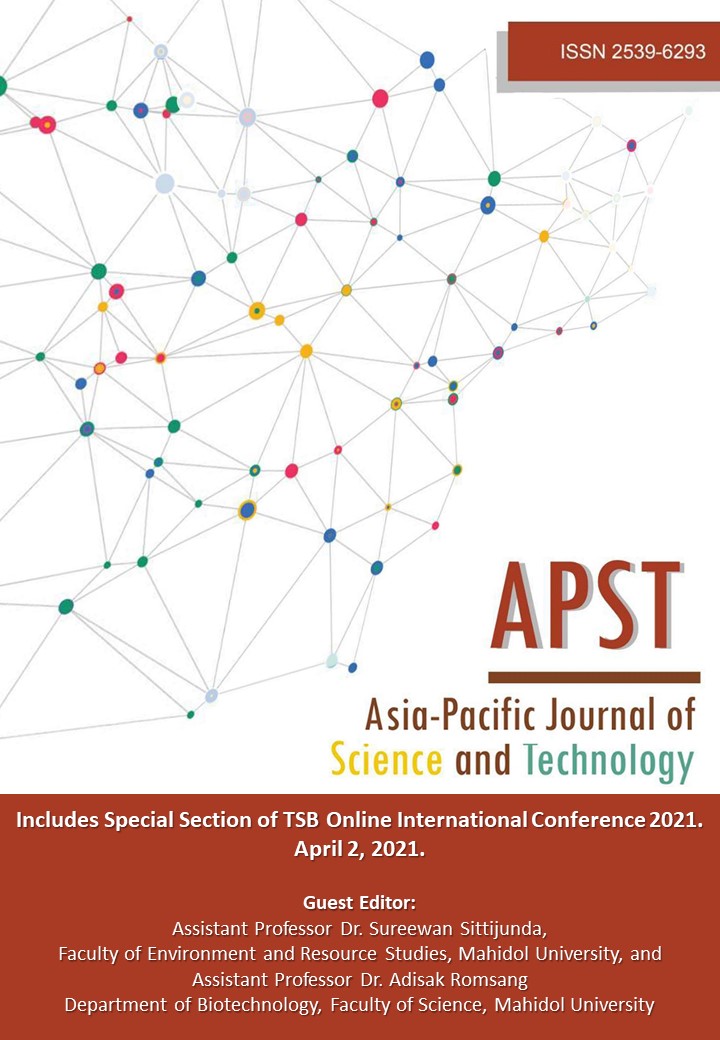Release of alcohol oxidase 1 (AOX1) from Pichia pastoris during heterologous expression of rice enzymes
Main Article Content
Abstract
Pichia pastoris is a popular host for recombinant expression of proteins due to its ability to secrete proteins, grow at high cell density with methanol as a carbon source, and support methanol-induced protein expression with the alcohol oxidase 1 (AOX1) promoter. However, overproduction of native proteins in the medium during induction may decrease its advantage as a host for heterologous protein expression. Here, we sought to identify what native protein is overexpressed in the medium during heterologous expression of rice enzymes in P. pastoris. The genes encoding rice enzymes, including Os4BGlu11 β-glucosidase and two putative serine carboxypeptidase-like acyltransferases, OsSCPL2a and OsSCPL7, were inserted in the pPICZαBNH8 expression vector and used to transform P. pastoris. Upon induction of expression, a 75 kDa protein was observed in the medium of cells expressing OsSCPL7 and Os4BGlu11 but not in OsSCPL2a. The protein was purified by immobilized metal affinity chromatography from the media, excised from sodium dodecyl sulphate-polyacrylamide gel electrophoresis (SDS-PAGE) gels, and identified by liquid chromatography and tandem mass spectrometry (LC/MS/MS) as P. pastoris alcohol oxidase 1 (AOX1) protein. The purified AOX1 was found to convert cyanidin-3-O-glucoside to compounds that no longer exhibit absorbance in the 520 nm range, but absorb relatively strongly at 360 nm, as detected in ultra-high-performance liquid chromatography. These results suggest that although it is normally found in the peroxisome, AOX1 protein may be released into medium during expression of certain proteins, but not other closely related proteins, and that AOX1 has the ability to oxidize complex phenolic alcohols, such as anthocyanins.
Article Details

This work is licensed under a Creative Commons Attribution-NonCommercial-NoDerivatives 4.0 International License.
References
Cregg JM, Cereghino JL, Shi J, Higgins DR. Recombinant protein expression in Pichia pastoris. Mol Biotechnol. 2000;16(1):23-52.
Koch C, Neumann P, Valerius O, Feussner I, Ficner R. Crystal structure of alcohol oxidase from Pichia pastoris. PLoS One. 2016;11(2):e0149846.
Kiess M, Hecht HJ, Kalisz HM. Glucose oxidase from Penicillium amagasakiense: primary structure and comparison with other glucose‐methanol‐choline (GMC) oxidoreductases. Eur J Biochem. 1998;252(1): 90-99.
Goswami P, Chinnadayyala SS, Chakraborty M, Kumar AK, Kakoti A. An overview on alcohol oxidases and their potential applications. Appl Microbiol Biotechnol. 2013;97(10):4259-4275.
Ozimek P, Veenhuis M, van der Klei IJ. Alcohol oxidase: a complex peroxisomal, oligomeric flavoprotein. FEMS Yeast Res. 2005;5(11):975-983.
Lombard V, Ramulu HG, Drula E, Coutinho PM, Henrissat, B, The carbohydrate-active enzymes database (CAZy) in 2013, Nucleic Acids Res. 2014; 42(D1):D490-D495.
Ketudat Cairns JR, Esen A. β-Glucosidases. Cell Mol Life Sci. 2010;67:3389-3405.
Li AX, Steffens JC. An acyltransferase catalyzing the formation of diacylglucose is a serine carboxypeptidase-like protein. Proc Natl Acad Sci USA. 2000;97(12):6902-6907.
Khoo HE, Azlan A, Tang ST, Lim SM. Anthocyanidins and anthocyanins: colored pigments as food, pharmaceutical ingredients, and the potential health benefits. Food Nutr Res. 2017;61(1):1361779.
Yoshida K, Mori M, Kondo T. Blue flower color development by anthocyanins: from chemical structure to cell physiology. Nat Prod Rep. 2009;26(7):884-915.
Fraser CM, Thompson MG, Shirley AM, Ralph J, Schoenherr JA, Sinlapadech T, et al. Related arabidopsis serine carboxypeptidase-like sinapoylglucose acyltransferases display distinct but overlapping substrate specificities. Plant Physiol. 2007;144(4):1986-1999.
Noda N, Higaki T, Sano T, Kazuma K, Sasaki T, Hasegawa S, et al. The structural localization and substrate specificity of 1-O-acylglucose dependent anthocyanin acyltransferase from blue petals of butterfly pea (Clitoria ternatea). Plant Cell Physiol. 2007;48:S222.
Nishizaki Y, Yasunaga M, Okamoto E, Okamoto M, Hirose Y, Yamaguchi M, et al. p-Hydroxybenzoyl-glucose is a Zwitter donor for the biosynthesis of 7-polyacylated anthocyanin in delphinium. Plant Cell. 2013;25(10):4150-4165.
Toonkool P, Metheenukul P, Sujiwattanarat P, Paiboon P, Tongtubtim N, Ketudat-Cairns M, et al. Expression and purification of dalcochinase, a β-glucosidase from Dalbergia cochinchinensis Pierre, in yeast and bacterial hosts. Protein Expr Purif. 2006;48:195-204.
Zhou A, Jiang X, Xu X. Improved alkaline lysis method for rapid isolation of plasmid DNA. Biotechniques. 1997;23(4):592-594.
Kotchoni SO, Gachomo EW, Betiku E, Shonukan OO. A home made kit for plasmid DNA mini-preparation. Afr J Biotechnol. 2003;2(4):88-90.
Kumar R. Simplified protocol for faster transformation of (a large number of) Pichia pastoris strains. Yeast. 2019;36(6):399-410.
Inan M, Aryasomayajula D, Sinha J, Meagher MM. Enhancement of protein secretion in Pichia pastoris by overexpression of protein disulfide isomerase. Biotechnol Bioeng. 2006;93(4):771-778.
Hays FA, Roe-Zurz Z, Stroud RM. Overexpression and purification of integral membrane proteins in yeast. Methods Enzymol. 2010;470:695-707.
Shevchenko A, Wilm M, Vorm O, Mann M. Mass spectrometric sequencing of proteins from silver-stained polyacrylamide gels. Anal Chem. 1996;68(5):850-858.
Wall MJ, Crowell AM, Simms GA, Liu F, Doucette AA. Implications of partial tryptic digestion in organic-aqueous solvent systems for bottom-up proteome analysis. Anal Chim Acta. 2011;703(2):194-203.
Sari DRT, Paemanee A, Roytrakul S, Ketudat CJR, Safitri A, Fatchiyah F. Black rice cultivar from Java Island of Indonesia revealed genomic, proteomic, and anthocyanin nutritional value. Acta Biochim Pol. 2021;68:5386.
Cereghino JL, Cregg JM. Heterologous protein expression in the methylotrophic yeast Pichia pastoris. FEMS Microbiol Rev. 2000;24(1):45-66.
Kurtzman CP. Biotechnological strains of Komagataella (Pichia) pastoris are Komagataella phaffii as determined from multigene sequence analysis. J Ind Microbiol Biotechnol. 2009;36(11):1435.
Barnett JP, Scanlan DJ, Blindauer CA. Fractionation and identification of metalloproteins from a marine cyanobacterium. Anal Bioanal Chem. 2012;402:3371-3377.
Qin C, Li Y, Niu W, Ding Y, Zhang R, Shang X. Analysis and characterization of anthocyanins in mulberry fruit. Czech J Food Sci. 2010;28(2):117-126.
Bowman SM, Free SJ. The structure and synthesis of the fungal cell wall. BioEssays. 2006;28:799-808.
Xu Z, Shih MC, Poulton JE. An extracellular exo-β-(1,3)-glucanase from Pichia pastoris: purification, characterization, molecular cloning, and functional expression. Protein Expr Purif. 2006;47:118-127.


